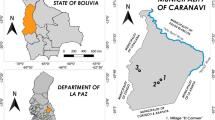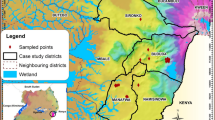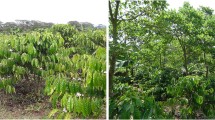Abstract
Coffea arabica L. is one of the major economically important crops grown in the southwestern part of Ethiopia. However, the productivity of coffee is very low in the region. The main aim of the study was to assess the determinants of arabica coffee yield and farmers’ preference to shade tree species in Jimma zone, Southwestern Ethiopia. Two districts (Chora Botor and Limu Kossa) were selected purposively out of nine coffee-growing districts in Jimma zone. Three kebeles from Chora Botor and five kebeles from Limmu Kossa were randomly selected to run the household survey (399 randomly selected coffee growers). The collected data were analyzed using SPSS and STATA software. Ordinary least square regression models were implemented to resolve the determinant of coffee yield. The results indicated that socioeconomic and biophysical factors such as gender, education level, family size, coffee-growing experience, coffee farm size, weed management practices, disease, and insect pests were found to be determinants of coffee yield. Although the scale of shade tree preferences varies, farmers prefer coffee shade trees that have long heights, wider crown shapes, and evergreen leaves throughout the growing season. Accordingly, the ranking analysis in both districts indicated that Albizia gummifera, Acacia abyssinica, and Millettia ferruginea were the greatest preferred coffee shade tree species by farmers of the study area. Hence, improving the capacity of farmers about coffee farm management skills and promoting the use of preferred coffee shade trees should be strengthened to improve the coffee yield and quality in the region.



Similar content being viewed by others
References
Abu T (2015) Ethiopia coffee annual report. Global Agricultural Information Network (GAIN) Report number ET1514, Addis Ababa Ethiopia
Adesoji SA, Farinde AJ (2006) Socio-economic factors influencing yield of arable crop in Osun State, Nigeria. Asian J Plant Sci 5(4):630–634
Adugna D, Paul C (2014) Effects of shade on growth, production, and quality of Coffee arabica in Ethiopia. J Hortic for 3(11):336–434
Aguilar A, Carranza E, Goldstein M, Kilic T, Oseni G (2014) Decomposition of gender differentials in agricultural productivity in Ethiopia. The World Bank
Albertin A, Nair P (2004) Farmers perspectives on the role of shade trees in coffee production: an assessment from the Nicoya Peninsula. Costa Rica J Hum Ecol 32(4):443–463
Anteneh N, Solomon E, Ashenafi A and Berhanu M (2010) Coffee production potentials and constraints in Darolabu District of West Hararge Zone. Research Report 83, Ethiopia Institute of Agricultural Research, Addis Ababa, Ethiopia
Ashenafi N, Endale T, Guta B (2014) Survey on potentials and constraints of shade tree species for Arabica coffee production in South Ethiopia. Int J Recent Res Life Sci 1:1–11
Beer J (1987) Advantages, disadvantages, and desirable characteristics of shade trees for coffee, cacao, and tea. Agrofor Syst 5:3–13
Beer J, Muschler R, Kass D, Somarriba E (1998) Shade management in coffee and cacao plantations. Agrofor Syst 38:139–164
Bhattarai C, Bhandari D, Bhandari S, Bhusal K, Khatri B, Srivastava A, Sapkota BK (2020) Factors affecting the productivity of coffee in Gulmi and Arghakhanchi districts of Nepal. J Agric Nat Resour 3(1):51–60
Bote A, Struik PC (2011) Effect of shade on growth, production, and quality of coffee (Coffea arabica) in Ethiopia. J Hortic for 3(11):336–341
Claudia PS (2010) Farmers‟ knowledge of tree attributes and shade canopy management of cocoa agroforestry systems in waslala. Nicaragua, Bangor
CSA (Central Statistical Agency) (2020/21) Agricultural sample survey. The Federal Democratic Republic of Ethiopia. Volume I Report on Area and Production of Major Crops (Private Peasant Holdings, Meher Season) Addis Abeba April 2021.
Deressa TT, Hassan RM, Ringler C, Alemu T, Yesuf M (2009) Determinants of farmers’ choice of adaptation methods to climate change in the Nile Basin of Ethiopia. Glob Environ Change 19(2):248–255
Diro S, Erko B (2019) Impacts of adoption of improved coffee varieties on farmers’ coffee yield and income in Jimma zone. J Agric Sci Technol 21(4):1–9
Diro S, Assefa S, Erko B (2016) Trends and determinants of coffee commercialization among smallholder farmers in Southwest Ethiopia: Jimma Zone Coffee Potential Districts. World J Agric Sci 12(2):138–148
Doss CR, Morris ML (2000) How does gender affect the adoption of agricultural innovations? Agric Econ 25(1):27–39
Emire A, Asfaw Z (2018) Coffee growers’ local knowledge on shade tree species in Adola Rede District, Guji Zone, Southern Ethiopia. Afr J Agric Res 13(40):2183–2191
Eshetu D and Girma A (2008) Management of moulds and mycotoxin contamination in coffee. In: Proceedings of a national workshop four decades of coffee research and development in Ethiopia. 14–17 August 2007, EIAR, Addis Ababa, Ethiopia. Pp. 271–278
Gebre GG, Isoda H, Rahut DB, Amekawa Y, Nomura H (2021) Gender differences in agricultural productivity: evidence from maize farm households in southern Ethiopia. Geo J 86(2):843–864
Gezahagn K (2019) Factors influencing coffee productivity in Jimma Zone, Ethiopia. World J Agric 15(4):228–234
Gole TM (2003) Vegetation of the Yayu Forest in Southwest Ethiopia: impacts of human use and implications for in situ conservation of wild Coffee Arabica. Populations. University of Bonn, Germany
Hayes AF, Matthes J (2009) Computational procedures for probing interactions in OLS and logistic regression: SPSS and SAS implementations. Behav Res Methods 41(3):924–936
Israel GD (2012) Determining sample size, agricultural education and communication department, Florida cooperative extension service, institute of food and agricultural sciences. University of Florida. Science and Education. An Open Access and Academic Publisher, Florida
Kangile JR, Kadigi RM, Mgeni CP, Munishi BP, Kashaigili J, Munishi PK (2021) The role of coffee production and trade on gender equity and livelihood improvement in Tanzania. Sustainability 13(18):10191
Kikkawa R (2018) Ethiopia coffee business marubeni research institute sub saharan report [Business Plus], Johannesburg, South Africa
Mekonnen B, Belehu T (2007) The experience of coffee plantation development enterprise in Ethiopia. Coffee plantation and development enterprise, Addis Ababa, Ethiopia. Pp. 20
Minai JM, Nyairo N, Mbataru P (2014) Analysis of socio-economic factors affecting the coffee yields of smallholder farmers in Kirinyaga County. Kenya J Agric Crop Res 2(12):228–235
Mohammedsani AA (2014) Assessment of factors affecting quality of hararge coffee (Coffea arabica L.) in coffee value chain: a case study of Darolabu District, Eastern Ethiopia. Project submitted in partial of the requirements for the degree of Master of Science. Wageningen.
Mukasa AN and Salami AO (2015) Gender productivity differentials among smallholder farmers in Africa: a cross-country comparison. Working Paper Series No. 231, African Development Bank, Abidjan, CotedIvoire
Muleta D, Assefa F, Nemomissa S, Granhall U (2011) Socioeconomic benefits of shade trees in coffee production systems in Bonga and Yayuhurumu Districts, Southwestern Ethiopia: farmers’ Perceptions. Ethiop J Educ Sci 7:39–56
Nchare A (2007) Analysis of factors affecting the technical efficiency of Arabica coffee producers in Cameroon. African Economic Research Consortium Research paper, Nairobi, Kenya
Njuki M, Kihiyo M, Oktingati A and Place F (2006) Productivity differences between male and female managed farms in the Eastern and Central Highlands of Kenya. 123 Geo Journal (2021) 86:843–864 863 Contributed paper prepared for presentation at the International Association of Agricultural Economists Conference, Gold Coast, Australia
Oseni G, Corral P, Goldstein M, Winters P (2015) Explaining gender differentials in agricultural production in Nigeria. Agric Econ 46(3):285–310
Paulos D. and Tesfaye S (2000) Some ecological parameters occurring in the major coffee growing areas of Southwestern and Southern Ethiopia. In: Proceedings of the Workshop on control of coffee Berry Disease in Ethiopia pp. 533–539
Population and Housing Census (2007) Result for Oromia region Volume 1 November 2011
Samuel AY (2012) Farmers‟ Perception about the integration and management of shade trees in Cocoa farm (The obroma cacao L.) at Ejisu-Juben district, Ghana. https://www.academia.edu.
Santos R, Rodrigues L, Lima C, Jaramillo B (2012) Coffee yield and microenvironmental factors in a native tree agroforestry system in Southeast Minas Gerais. Brazil J Sustain Agric 36(1):54–68
Senkondo E, Mdoe Y, Hatibu N, Mahoo H, Gowing J (2004) Factors affecting the adoption of rainwater harvesting technologies in western pare lowlands of Tanzania. Tanzan J Agric Sci 1(1):81–89
Soto-Pinto L, Villalvazo-Lopez V, Jimenez-Ferrer G, Ramirez-Marcial N, Montoya G, Sinclair FL (2007) The role of local knowledge in determining shade composition of multi-strata coffee systems in Chiapas, Mexico. Biodivers Conserv 16:419–436
Staver C, Guharay F, Monterroso D, Muschler RG, Beer J (2001) Designing Pest suppressive multistrata perennial crop systems: Shade-grown coffee in Central America. Agrofor Syst 53:151–170
Sualeh A, Tesfa M, Mekonene N, Girma B, Tamirat W, Alemayehu D, Beyeta A, Haile T (2022) Coffee quality profile of Jimma Zone, Southwestern Ethiopia. Int J Food Sci Biotechnol 7(2):48–53
Temesgen F, Getachew B (2018) Analysis of technical efficiency of coffee production on small holder farmers in case of Sasiga and Limu District of East Wollega Zone. J Econ Sustain Dev 6(2):30–44
Van der Vossen H (2005) A critical analysis of the agronomic and economic sustainability of organic coffee production. Exper Agric 41:449–473
Ward NL, Masters GJ (2007) Linking climate change and species invasion: an illustration using insect herbivores. Glob Chang Biol 13(8):1605–1615
Wintgens JN (2004) The coffee plants. Coffee: growing, processing, sustainable production: a guidebook for growers, Processors, Traders, and Researchers. Wiley‐VCH Verlag GmbH and Co. KGaA, Weimheim, Germany. pp. 1–24
Yamane T (1967) Statistics, an introductory analysis, 2nd edn. Harper and Row, New York
Zemedu W (2004) Socio-economic facts that limit food production in Ethiopia. Bull Forum Social Stud 2(1):9–14
Author information
Authors and Affiliations
Contributions
All Authors help the corresponding author with comments and suggestions in the manuscript written.
Corresponding author
Additional information
Publisher's Note
Springer Nature remains neutral with regard to jurisdictional claims in published maps and institutional affiliations.
Rights and permissions
Springer Nature or its licensor (e.g. a society or other partner) holds exclusive rights to this article under a publishing agreement with the author(s) or other rightsholder(s); author self-archiving of the accepted manuscript version of this article is solely governed by the terms of such publishing agreement and applicable law.
About this article
Cite this article
Misgana, Z., Garedew, W., Alemayehu, Y. et al. Determinants of Arabica coffee yield and farmers’ preference to shade trees species at Jimma Zone, Southwestern Ethiopia. Agroforest Syst 98, 401–413 (2024). https://doi.org/10.1007/s10457-023-00918-z
Received:
Accepted:
Published:
Issue Date:
DOI: https://doi.org/10.1007/s10457-023-00918-z




